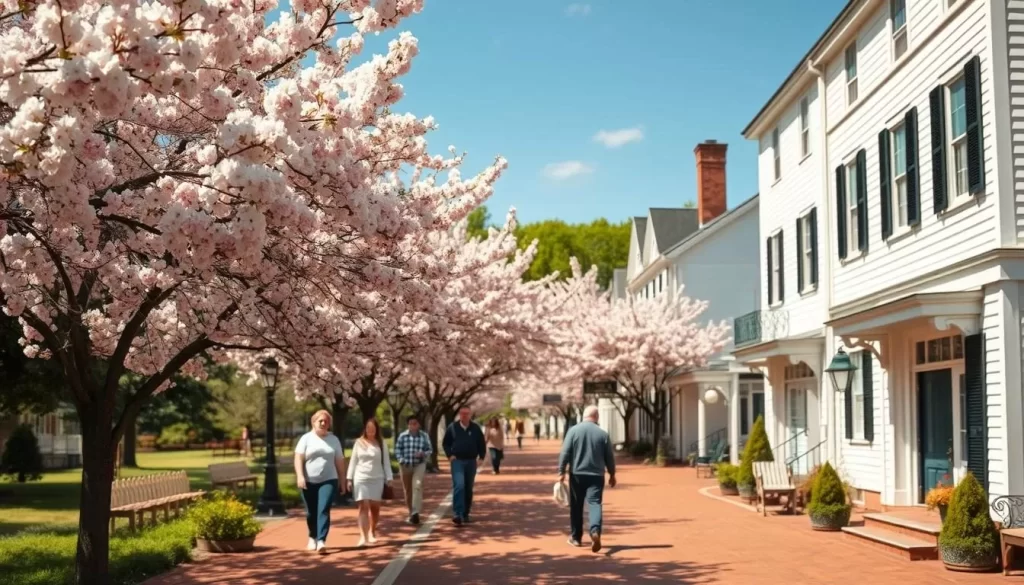✓ Accommodations ✓ Flights ✓ Rental Cars ✓ Tours & Activities
Planning a trip to Massachusetts can be a delightful experience, especially when you consider the weather and seasonal activities.
The city offers diverse experiences throughout the year, from the spring blooms to the vibrant fall foliage, summer beach trips, and winter holiday festivities.
Understanding the temperatures and weather conditions is crucial to making the most of your trip. You’ll want to align your visit with the activities you have planned, whether it’s enjoying outdoor pursuits or exploring indoor attractions.
By considering the seasonal characteristics, you can ensure a weather-savvy trip that meets your preferences.
Understanding Massachusetts’ Four Seasons
Massachusetts’ climate is a complex blend of continental and maritime influences, making it a fascinating study in seasonal variation. The state’s weather can be quite unpredictable, with the possibility of snowstorms as early as November and as late as April.
This unpredictability is due in part to its location in the New England region, where the jet stream and storm tracks play a significant role in shaping the weather patterns.
Geographic Influences on Weather Patterns
The diverse geography of Massachusetts, from the coastline to the mountains, significantly influences its climate. The maritime influence moderates coastal temperatures, while the inland areas experience more extreme variations. This geographic diversity contributes to the distinct seasonal experiences across the state.
What Makes Massachusetts Weather Unique
Massachusetts experiences a distinct seasonal cycle, with each season bringing its own characteristics. The “January thaw” phenomenon, where temperatures rise briefly in the middle of winter, is one of the quirky weather patterns that residents have come to expect. Understanding these patterns can help you prepare for the variability in weather conditions.
| Season | Characteristics | Weather Patterns |
|---|---|---|
| Spring | Renewal, mild temperatures | Unpredictable rain and sunshine |
| Summer | Warmth, beach activities | Hot temperatures, occasional storms |
| Autumn | Foliage, cooling temperatures | Foliage peak, occasional rain |
| Winter | Cold, snowstorms | Snow, freezing temperatures |
Spring in Massachusetts: March to May
With the arrival of spring, Massachusetts awakens from its winter slumber, offering a fresh palette of experiences. The season brings a gradual warming trend, transforming the state’s landscapes and making it an attractive time to visit.
March: Winter’s Last Stand
March is a transitional month in Massachusetts, where winter’s chill still lingers. Temperatures can fluctuate significantly, ranging from chilly mornings to milder afternoons. Despite the unpredictability, early spring blooms start to appear, signaling the end of winter.
April: Embracing Spring Renewal
April marks a significant shift towards spring, with renewed vitality evident in the state’s flora. As the weather becomes milder, with temperatures rising into the 50s and 60s, the outdoors becomes more inviting. It’s an excellent time for outdoor activities like hiking and exploring.
May: The Sweet Spot Before Summer
May is considered one of the best times to visit Massachusetts. The weather is typically mild, with comfortable temperatures in the 60s, making it ideal for outdoor exploration. Events like Lilac Sunday and the Duckling Day Parade celebrate the full arrival of spring, adding to the state’s charm.
You’ll enjoy coastal walks, garden tours, and harbor cruises in May, taking advantage of the pleasant weather and pre-summer tranquility. The balance of comfortable temperatures, sunshine, and manageable crowds makes May a sweet spot for travelers.
Summer in Massachusetts: June to August
When summer arrives, Massachusetts is at its most vibrant, with warm weather and a range of activities. The summer months bring a unique charm to the Bay State, making it an ideal time to visit.
June: Early Summer Charm
June marks the beginning of summer in Massachusetts, with early summer charm evident in its mild temperatures and longer days. It’s an excellent time for beach activities, as the ocean temperatures start to rise. You can enjoy the summer vibes in cities like Boston, where outdoor events start to take center stage.
July: Peak Summer Heat and Activities
July is the peak of summer in Massachusetts, with temperatures often reaching the low 80s. It’s the perfect time for water activities, with the ocean at its warmest. The city hosts various festivals and events, making it a bustling time for tourists.
August: Late Summer Perfection
August continues the warm trend, with temperatures similar to July but with fewer big events. However, most schools haven’t started yet, so you’ll find plenty of families enjoying the city. The weather remains pleasant, making it ideal for outdoor exploration and enjoying the beach. The Free August Adventures program and North End Feasts offer unique cultural experiences during this late summer month.
August offers a perfect blend of summer warmth and early hints of fall, creating ideal conditions for enjoying Massachusetts’ diverse attractions. With temperatures in the low80s and lower humidity than July, outdoor activities are comfortable.
Fall in Massachusetts: September to November
The fall season in Massachusetts is a treat for the senses, with September marking the beginning of a beautiful transition. As the summer heat dissipates, the air cools, and the foliage transforms into a kaleidoscope of colors.
September: The Golden Month
September is a great time to enjoy the outdoors in Massachusetts. The weather is generally mild, with average highs in the 70s and 80s Fahrenheit. It’s an ideal month for activities like hiking, biking, and visiting the many parks and gardens throughout the state.
October: Fall Foliage at Its Peak
October is when the fall foliage is at its peak, with the changing leaves creating a stunning landscape. The temperatures continue to cool, making it a comfortable time for outdoor activities like apple picking and visiting the many fall festivals.
November: The Transition to Winter
November marks the transition from fall to winter in Massachusetts. The weather can be quite variable, with temperatures cooling significantly and the possibility of the season’s first light snowfall. Despite the chill, November has its charms, with holiday celebrations beginning and many indoor attractions to explore.
| Month | Average High Temperature | Notable Events |
|---|---|---|
| September | 75°F | Fall festivals, outdoor activities |
| October | 65°F | Peak fall foliage, apple picking |
| November | 55°F | Holiday celebrations, first snowfall |
Winter in Massachusetts: December to February
Winter in Massachusetts is a season of magic, with December, January, and February offering a range of experiences that cater to different interests. The winter months bring a chill in the air, but the state’s festive atmosphere and outdoor activities make it a great time to visit.
December: Holiday Magic
December is a month of holiday magic in Massachusetts. The weather is cold, but the state’s festive atmosphere, with decorations, lights, and events, makes it a wonderful time to visit. You can enjoy ice skating at outdoor rinks, such as the one at the Boston Common Frog Pond, or explore the holiday markets and festivities.
January: The Heart of Winter
January is the heart of winter in Massachusetts, with the coldest temperatures of the year. Despite the chill, there are plenty of activities to enjoy, from skiing and snowboarding to visiting the winter festivals and events. The weather is typically cold and snowy, with averages ranging from 24°F to 34°F (-4°C to 1°C).
February: Winter’s Final Chapter
February represents winter’s final chapter in Massachusetts, with the weather remaining cold but occasionally showing signs of moderation as the month progresses. You can enjoy the events like the Beanpot hockey tournament and Chinese New Year celebrations, which brighten the winter season. It’s also a great time for ice skating and exploring snow-covered hiking trails in less crowded state parks.
The Best Months for a Weather-Savvy Trip to Massachusetts
Massachusetts offers a diverse range of experiences throughout the year, but some months are better than others for a weather-savvy trip. The state’s climate varies significantly across the seasons, with certain months standing out for their pleasant weather and exciting events.
May and June: Perfect Spring Weather
As spring transitions into summer, May and June become ideal months to visit Massachusetts. The weather is mild, with comfortable temperatures ranging from the mid-60s to mid-70s Fahrenheit. This period is perfect for outdoor activities like walking along the Charles River Esplanade or exploring the many parks in Boston. The spring renewal is in full bloom, making the landscape particularly picturesque.

September and October: Ideal Fall Conditions
Fall is another fantastic season to visit Massachusetts, with September and October being the highlight. The fall foliage transforms the state into a picturesque landscape, with the leaves changing colors creating a breathtaking scenery. The weather during these months is typically mild, with comfortable days and cool nights, making it perfect for outdoor activities. You’ll experience the harvest festivals and cultural events that make autumn in Massachusetts particularly special. The progression of fall foliage across the state, from the western Berkshires in late September to coastal areas in October, ensures that there’s always something new to explore.
Boston Weather Guide by Season
As you plan your trip to Boston, it’s vital to understand the city’s seasonal weather patterns. Boston’s weather is characterized by its distinct seasons, with varying temperatures and precipitation levels throughout the year.
Temperature Ranges Throughout the Year
Boston’s temperature ranges from warm summers to cold winters. Summer temperatures typically range from 70°F to 85°F (21°C to 30°C), while winter temperatures can drop below freezing, ranging from 20°F to 40°F (-7°C to 4°C). In spring and fall, temperatures are mild, ranging from 50°F to 70°F (10°C to 21°C), making these seasons ideal for outdoor activities.
Precipitation Patterns in Boston
Boston experiences precipitation throughout the year, with no distinct rainy season. November has been observed as the rainiest month in recent years. The city’s coastal location influences its precipitation patterns, with February being typically the snowiest month. Snowfall can occur from December to April, with varying accumulations each year. Understanding these patterns can help you prepare for your visit and make the most of your time in Boston.
Cape Cod and Coastal Massachusetts Weather
Exploring Cape Cod and coastal Massachusetts means encountering a range of weather conditions that are shaped by their maritime location. The unique geography of these areas not only influences the climate but also creates distinct microclimates that visitors should be aware of.
Beach Season: When to Hit the Shore
The summer months are the peak season for visiting the beaches of Cape Cod and coastal Massachusetts. In August, places like Martha’s Vineyard experience warm and humid conditions, with highs between 79°F and 82°F, cooling down to the mid-60s°F at night. The sea’s influence helps keep temperatures more bearable than in inland areas. If you’re planning to enjoy the beaches, summer is the ideal time, but be prepared for the crowds.
Coastal Weather Considerations
Understanding the coastal weather is crucial for making the most of your visit. Factors such as fog patterns, sea breezes, and maritime influences significantly affect daily conditions. Additionally, coastal storms and weather systems impact the beaches differently throughout the year, from summer thunderstorms to winter nor’easters. Being aware of these conditions and knowing how to interpret weather forecasts will help you prepare for the variable conditions along Massachusetts’ shoreline.
Western Massachusetts Weather Patterns
Exploring Western Massachusetts reveals a region with unique weather patterns, shaped by its geography. The area encompasses the Berkshires and the Pioneer Valley, each with its own distinct climate characteristics.
Berkshires Climate Variations
The Berkshires, known for their mountainous terrain, experience a climate that is quite different from the rest of Massachusetts. Temperatures vary significantly with elevation, making the higher areas cooler than the lower valleys. During spring, the region comes alive with blooming flowers and greenery, while fall brings spectacular foliage. Visitors can enjoy scenic drives along routes like the Mohawk Trail, which spans 33 miles between Williamstown and Shelburne Falls.

Pioneer Valley Weather Expectations
The Pioneer Valley, situated along the Connecticut River, has a climate influenced by its location between mountain ranges. This creates distinct weather conditions, with moderate temperatures and fertile soil that has shaped the region’s agricultural heritage. During different seasons, the valley offers various attractions, from spring flowering to summer farm visits and spectacular fall foliage. The region’s unique climate zone is characterized by transitions between coastal and mountain weather patterns.
| Region | Spring Weather | Fall Weather |
|---|---|---|
| Berkshires | Mild temperatures, blooming flowers | Cool temperatures, foliage |
| Pioneer Valley | Moderate temperatures, agricultural activities | Mild temperatures, harvest season |
Outdoor Activities by Season
From hiking and biking in the spring to skiing and ice skating in the winter, Massachusetts transforms into an outdoor playground across the seasons. The state’s diverse landscape and climate offer a wide range of activities for all interests and ages.
Spring and Summer Adventures
During spring and summer, you can enjoy hiking, biking, and various water sports. The warmer months are ideal for exploring Massachusetts’ beautiful coastline and countryside.
- Hike through the scenic trails of the Blue Hills Reservation
- Enjoy kayaking or paddleboarding in the numerous lakes and rivers
- Visit the beaches along Cape Cod for swimming and sunbathing
Fall and Winter Experiences
As fall arrives, the foliage creates a picturesque backdrop for hiking and leaf peeping. In winter, the state becomes a haven for skiing, snowboarding, and ice skating.
| Season | Popular Activities |
|---|---|
| Fall | Hiking, Leaf Peeping, Bird Watching |
| Winter | Skiing, Snowboarding, Ice Skating |
Indoor Attractions for Weather Challenges
You don’t have to let the weather dampen your Massachusetts trip, thanks to numerous indoor attractions. The state is rich in cultural, shopping, and dining experiences that can be enjoyed regardless of the weather outside.
Museums and Cultural Venues
Massachusetts is home to world-class museums and cultural venues. You can explore the Museum of Fine Arts in Boston, which houses an extensive collection of art from around the world. The Institute of Contemporary Art is another must-visit, featuring cutting-edge contemporary art exhibitions. These cultural hotspots provide a perfect refuge from harsh winter weather or unexpected rain showers.
Shopping and Dining Experiences
For a more leisurely indoor activity, you can indulge in Massachusetts’ diverse shopping and dining scenes. Visit Faneuil Hall Marketplace and Quincy Market in Boston for a mix of shopping, dining, and street entertainment. You can also explore Newbury Street for upscale shopping and dining. The state’s premium outlets and charming town centers across various cities offer a unique shopping experience. When it comes to dining, Massachusetts is renowned for its culinary landscape, featuring historic food markets, award-winning restaurants, and food halls showcasing local specialties.
Special Events and Festivals by Season
Massachusetts’ events and festivals are an integral part of its charm, offering something for everyone, regardless of the time of year you visit. The state’s diverse calendar is filled with exciting celebrations that cater to different interests and preferences.
Celebrations that Depend on the Weather
Some events in Massachusetts are directly influenced by the weather. For instance, the summer solstice celebrations take advantage of the long days and warm weather, while winter festivals like the Boston Common’s Frog Pond Ice Skating make the most of the snowy season. You’ll find that many outdoor events are scheduled during the milder spring and fall seasons, making the most of the comfortable temperatures.

Indoor Events That Take Place Throughout the Year
Massachusetts also offers a wide range of indoor events that take place throughout the year, ensuring that there’s always something to do, regardless of the weather. You can enjoy Boston Wine Festival, Boston Ballet performances, and various museum exhibition openings. The state’s historic venues host special indoor events that connect visitors with Massachusetts’ rich cultural heritage, making for a memorable experience.
Packing Tips for Massachusetts Weather
To make the most of your time in Massachusetts, be prepared for variable weather conditions. The state’s climate can be quite unpredictable, with significant changes throughout the day. Understanding how to pack for these conditions is crucial for a comfortable and enjoyable trip.
Seasonal Essentials
When planning your trip to Massachusetts, it’s essential to consider the season. For spring and fall, pack layers as temperatures can fluctuate significantly. A compact umbrella is also a must-have due to potential rain showers. In the summer, lightweight clothing and sun protection are key. Winters require warm, layered clothing, including a heavy coat, gloves, and hat.
| Season | Essential Items |
|---|---|
| Spring | Layers, compact umbrella, light jacket |
| Summer | Lightweight clothing, sunscreen, sunglasses |
| Fall | Layers, warm sweater, comfortable shoes |
| Winter | Heavy coat, gloves, hat, warm socks |
Layering Strategies for Unpredictable Weather
Layering is a crucial strategy for dealing with Massachusetts’ changeable weather. The “three-layer system” is recommended: a base layer for moisture-wicking, an insulating layer for warmth, and an outer layer for wind and rain protection. This allows you to adjust your clothing throughout the day to stay comfortable. Versatile things like scarves and hats can also be added or removed as needed.
Avoiding Crowds: Off-Peak Travel Months
To make the most of your Massachusetts adventure, it’s crucial to plan around the times when crowds are at their smallest. For the most economical option, consider visiting Boston in January or February, when you can enjoy the city’s charm with fewer tourists.
Shoulder Season Benefits
Visiting during the shoulder season, which includes the periods before and after the peak tourist season, can offer several benefits. You’ll have a more relaxed experience at popular attractions, and you’ll likely find better deals on accommodations. The months of April and May, or September and October, are ideal for enjoying mild weather and smaller crowds.
Weekday vs. Weekend Visitation
Understanding the difference in crowd patterns between weekdays and weekends can significantly enhance your trip planning. Popular destinations like Boston’s Freedom Trail and Cape Cod beaches tend to be more crowded on weekends. By visiting these places on a day during the week, you can avoid the crowds and have a more enjoyable experience. This strategy allows you to make the most of your time in Massachusetts.
Accommodation Considerations by Season
The weather in Massachusetts varies significantly throughout the year, making it essential to consider the season when booking your accommodation. This consideration not only enhances your comfort but also impacts your budget and the activities you can enjoy.
Peak vs. Off-Season Rates
Massachusetts experiences peak tourist season during the summer months and fall foliage season, leading to higher accommodation rates. In contrast, the off-season, typically during the spring and winter, offers more competitive pricing. For instance, visiting Cape Cod in June or July allows you to enjoy mild weather, with average highs in the mid-70s°F to low 80s°F, perfect for beach activities.
Understanding the difference between peak and off-season rates can help you plan your trip according to your budget. If you’re looking for savings, consider visiting during the shoulder season.
Best Locations Based on Weather
Different regions in Massachusetts offer unique weather experiences. Coastal areas like Cape Cod and the islands are ideal during the summer for their beaches and mild temperatures. In contrast, cities like Boston are more vibrant during the winter months, with indoor attractions and festivities. Knowing the season and weather patterns can help you choose the best location for your preferences.

For example, Martha’s Vineyard has a milder climate in June and July, making it perfect for enjoying the island’s stunning beaches and water activities. By choosing your accommodation based on the time of year and weather, you can maximize your enjoyment of Massachusetts’ diverse offerings.
Conclusion: Planning Your Weather-Perfect Massachusetts Trip
With the information provided, you’re ready to plan a weather-perfect trip to Massachusetts. You’ve learned that the Bay State offers distinct experiences throughout the year, allowing you to choose the season that best aligns with your weather preferences and activity interests.
The best months for a weather-savvy trip are generally May-June and September-October, offering ideal conditions with fewer crowds. Whether you’re seeking summer beach days, fall foliage, winter adventures, or spring renewal, Massachusetts has something for everyone. By considering factors like accommodation rates, crowd levels, and seasonal activities, you can create your perfect New England experience. You’re now equipped to plan a trip that suits your preferences, making the most of your time in Massachusetts.
The above is subject to change.
Check back often to TRAVEL.COM for the latest travel tips and deals.






